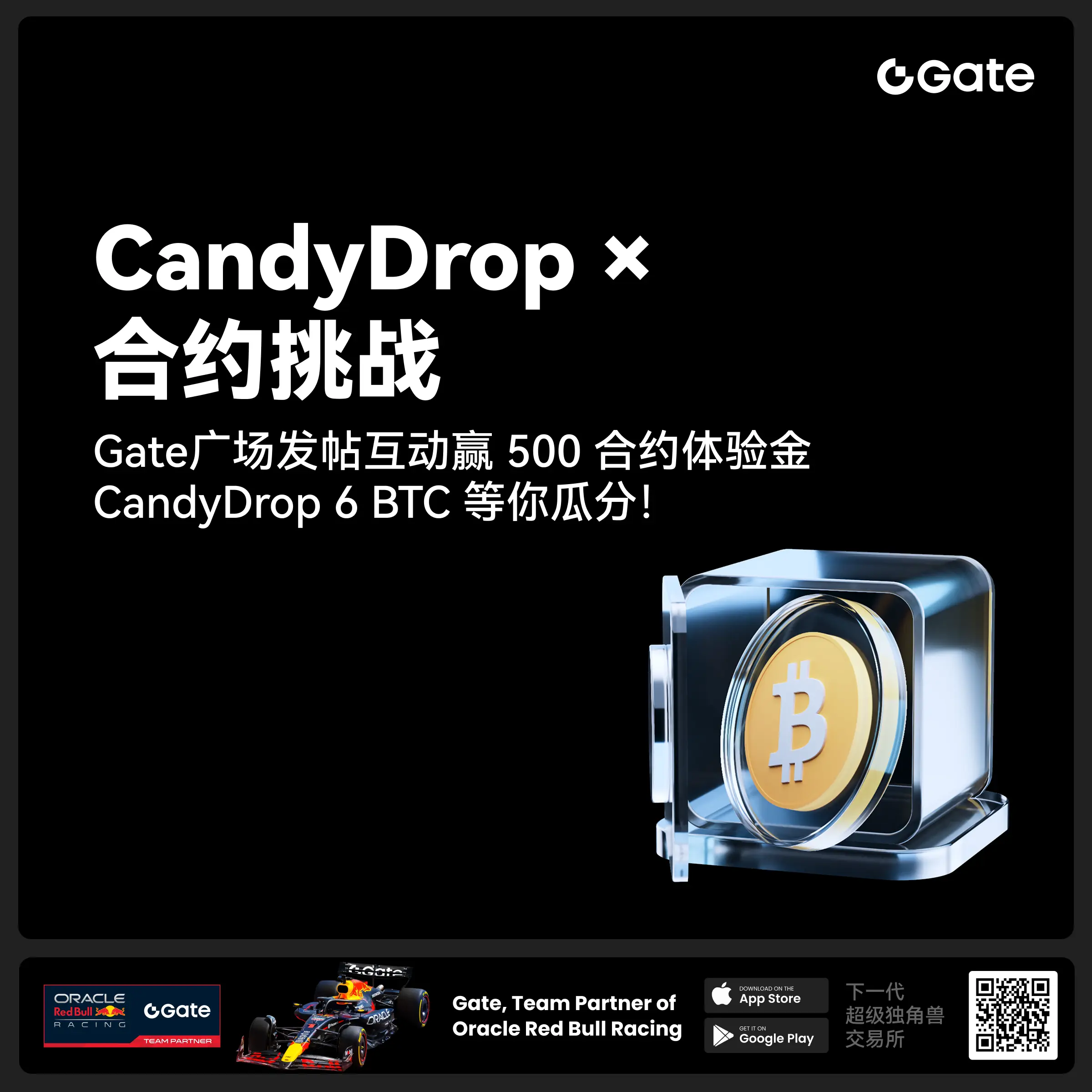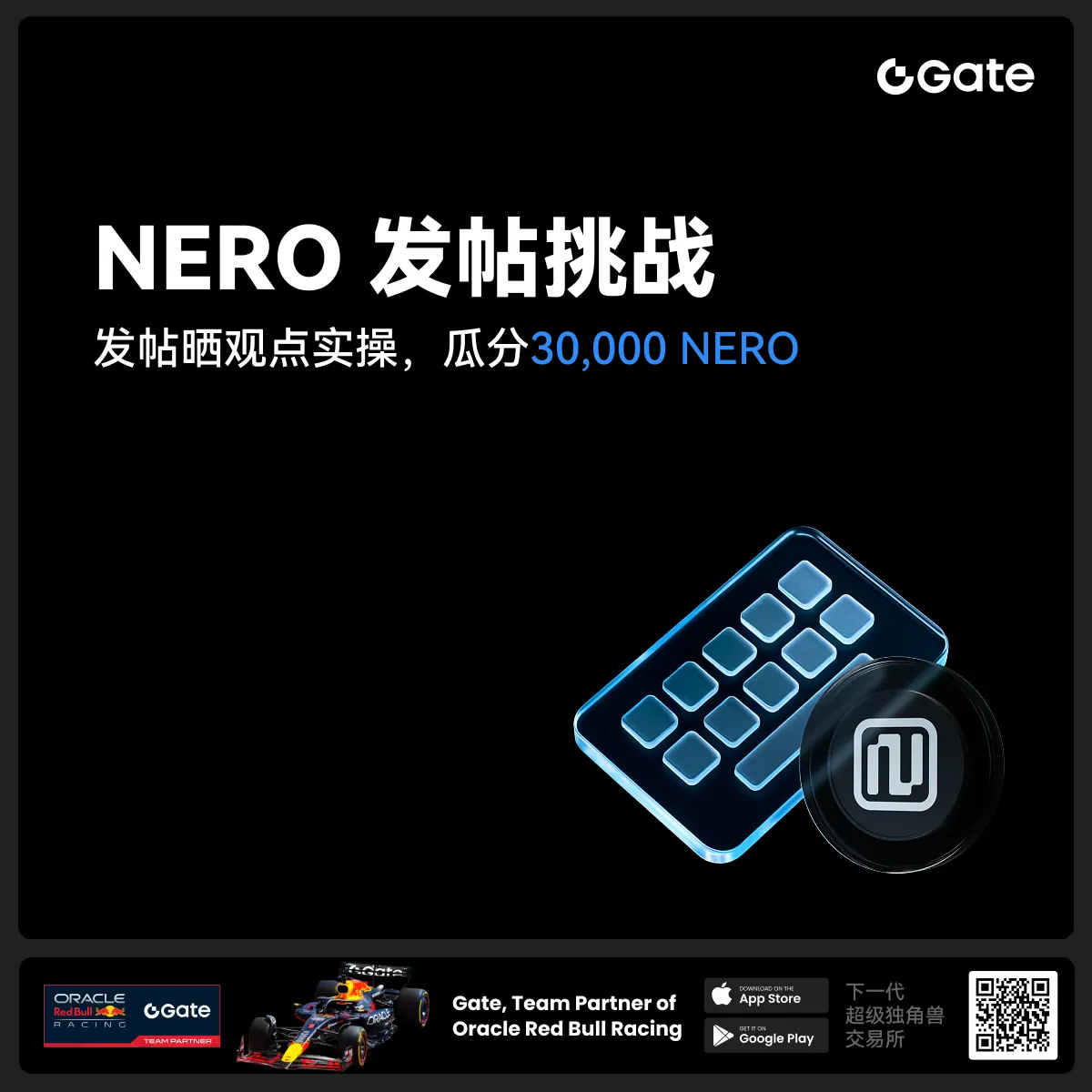- 话题1/3
40398 热度
27791 热度
44825 热度
7931 热度
21247 热度
- 置顶
- 🎉 #CandyDrop合约挑战# 正式开启!参与即可瓜分 6 BTC 豪华奖池!
📢 在 Gate 广场带话题发布你的合约体验
🎁 优质贴文用户瓜分$500 合约体验金券,20位名额等你上榜!
📅 活动时间:2025 年 8 月 1 日 15:00 - 8 月 15 日 19:00 (UTC+8)
👉 活动链接:https://www.gate.com/candy-drop/detail/BTC-98
敢合约,敢盈利
- 🎉 攒成长值,抽华为Mate三折叠!广场第 1️⃣ 2️⃣ 期夏季成长值抽奖大狂欢开启!
总奖池超 $10,000+,华为Mate三折叠手机、F1红牛赛车模型、Gate限量周边、热门代币等你来抽!
立即抽奖 👉 https://www.gate.com/activities/pointprize?now_period=12
如何快速赚成长值?
1️⃣ 进入【广场】,点击头像旁标识进入【社区中心】
2️⃣ 完成发帖、评论、点赞、发言等日常任务,成长值拿不停
100%有奖,抽到赚到,大奖等你抱走,赶紧试试手气!
截止于 8月9日 24:00 (UTC+8)
详情: https://www.gate.com/announcements/article/46384
#成长值抽奖12期开启#
- 📢 Gate广场 #NERO发帖挑战# 秀观点赢大奖活动火热开启!
Gate NERO生态周来袭!发帖秀出NERO项目洞察和活动实用攻略,瓜分30,000NERO!
💰️ 15位优质发帖用户 * 2,000枚NERO每人
如何参与:
1️⃣ 调研NERO项目
对NERO的基本面、社区治理、发展目标、代币经济模型等方面进行研究,分享你对项目的深度研究。
2️⃣ 参与并分享真实体验
参与NERO生态周相关活动,并晒出你的参与截图、收益图或实用教程。可以是收益展示、简明易懂的新手攻略、小窍门,也可以是行情点位分析,内容详实优先。
3️⃣ 鼓励带新互动
如果你的帖子吸引到他人参与活动,或者有好友评论“已参与/已交易”,将大幅提升你的获奖概率!
NERO热门活动(帖文需附以下活动链接):
NERO Chain (NERO) 生态周:Gate 已上线 NERO 现货交易,为回馈平台用户,HODLer Airdrop、Launchpool、CandyDrop、余币宝已上线 NERO,邀您体验。参与攻略见公告:https://www.gate.com/announcements/article/46284
高质量帖子Tips:
教程越详细、图片越直观、互动量越高,获奖几率越大!
市场见解独到、真实参与经历、有带新互动者,评选将优先考虑。
帖子需原创,字数不少于250字,且需获得至少3条有效互动
- 🎉 亲爱的广场小伙伴们,福利不停,精彩不断!目前广场上这些热门发帖赢奖活动火热进行中,发帖越多,奖励越多,快来GET你的专属好礼吧!🚀
1️⃣ #GateLaunchpad上线IKA# |IKA认购体验
在Gate广场带话题晒出你的IKA Launchpad认购体验,4位幸运分享者讲瓜分$200分享奖池!
详情 👉️ https://www.gate.com/post/status/12566958
2️⃣ #ETH冲击4800# |行情分析预测
大胆发帖预测ETH走势,展示你的市场洞察力!10位幸运用户将平分0.1 ETH 奖励!
详情 👉️ https://www.gate.com/post/status/12322403
3️⃣ #创作者活动第二期# |ZKWASM话题
在广场或推特发布与 ZKWASM 或其交易活动相关的原创内容,瓜分4,000枚ZKWASM!
详情 👉️ https://www.gate.com/post/status/12525794
4️⃣ #Gate广场征文活动第二期# |ERA话题
谈谈你对ERA的观点/体验,参与并推广活动,700 ERA大奖等你赢!
详情 👉️ https://www.gate.com/post/status/12361653
5️⃣ #MBG任务挑战# |MBG话题
分享你对MBG的洞察,积极参与和推广MBG活动,20位小 - 🎉Gate 2025 上半年社区盛典:内容达人评选投票火热进行中 🎉
🏆 谁将成为前十位 #Gate广场# 内容达人?
投票现已开启,选出你的心头好
🎁赢取 iPhone 16 Pro Max、限量周边等好礼!
📅投票截止:8 月 15 日 10:00(UTC+8)
立即投票: https://www.gate.com/activities/community-vote
活动详情: https://www.gate.com/announcements/article/45974
全链游戏深度解析:突破传统游戏困境的新范式
全链游戏深度研究:加密原生为核心,究竟是泡沫还是革命?
一、引言:全链游戏是什么?
近期全链游戏sky strife的Pass卡在测试网上的fomo达到了21000ETH,引发了许多非全链游戏玩家对这个赛道魔力的惊叹。自1972年《乒乓》诞生以来,游戏产业一路高速发展,从《超级马里奥》和《塞尔达传说》等经典8bit游戏,到如今的《堡垒之夜》和《英雄联盟》等复杂度高、社交性强的网络游戏,游戏早已不再是简单的娱乐消遣。这些游戏所带来的社交、竞争和沉浸体验已经超越了我们过去的想象。
随着区块链技术的兴起和加密货币的发展,游戏产业正以前所未有的方式重塑着我们的体验。从将游戏与加密经济紧密结合的Axie Infinity,到以社交与创新为核心的Stepn,区块链游戏逐渐被寄予作为加密技术大规模应用的厚望。人们也开始探索游戏和区块链结合的新方式,除了资产上链之外,还能不能将更多的元素上链?于是全链游戏应运而生。
那么全链游戏和传统的游戏究竟有什么区别呢?
在传统游戏中,所有的游戏逻辑、数据存储、数字资产和游戏状态都存储在中心化的游戏公司里。例如当我们玩王者荣耀、原神、DNF时,所有的游戏内容包括游戏内的资产也都归中心化的公司所有。
随后出现的资产上链游戏(常被称为Web2.5游戏),如Axie和Stepn,将资产上链。玩家一方面可以拥有资产的所有权,另一方面可以提高资产的流动性。然而当游戏倒闭时,游戏资产仍然会面临失去流通价值的困境。资产上链游戏和传统游戏的关系更像是一种补充而非替代,类似于外卖和餐饮门店的关系。Web2.5的游戏也同时面临着Web2.5同类游戏以及Web2传统游戏的竞争。
而最近备受关注的全链游戏将游戏所有的交互行为和状态全部上链,包括前面提到的游戏逻辑、数据存储、数字资产和游戏状态,全部由区块链处理,从而实现真正的去中心化游戏。
全链游戏的特征可以总结为以下4点:
数据来源的真实性由区块链确保。区块链不再仅仅作为数据的辅助存储,而是游戏数据的真实来源;不局限于仅是资产所有权的记录,而是所有关键数据的存储中心。这种方式充分利用了可编程区块链的特性,实现了透明的数据存储和无权限的互操作性。
游戏的逻辑和规则通过智能合约实现。例如,游戏中的各种操作,都可以在链上执行,确保游戏逻辑的可追溯性和安全性。
游戏开发遵循开放生态系统原则。游戏合约和可访问的游戏客户端都采用开源模式,为第三方开发者提供了广阔的创作空间。他们可以通过插件、第三方客户端和可互操作的智能合约,甚至重新部署和定制自己的游戏体验,创造性地输出内容并与整个社区共享。
游戏与客户端无关。这与前三点息息相关,因为真正加密原生游戏的关键在于,即使核心开发者的客户端消失,游戏依然可以继续进行。这取决于游戏数据的无权限存储、逻辑的无权限执行以及社区能够独立与核心智能合约互动的能力,而不依赖于核心团队提供的接口。从而真正的实现了去中心化。
二、为什么人类需要全链游戏?
在了解为什么需要全链游戏之前,我们先来简单了解下传统游戏行业的现状与运作模式。
全链游戏本质上也是游戏,了解传统游戏的运作模式对于我们理解和分析全链游戏的未来是非常重要和必要的。
1、传统游戏行业现状
伴随着游戏产业的发展,在我们成长的过程中诞生了非常多优秀的Web2游戏,无论是FPS类的反恐精英、穿越火线,还是RPG类型的地下城与勇士、龙之谷,还是moba类的英雄联盟、王者荣耀,亦或者是卡牌类的阴阳师、炉石传说,游戏伴随着我们这一代人的成长,占据了娱乐生活中非常重要的部分。
根据Fortune business insights的数据,2022年全球游戏市场规模为2495.5亿美元,预计2023年超过2800亿美元,到2030年会超过6000亿美元。横向对比电影文娱产业,2022年全球市场规模为944亿美元,可以看出同样作为文娱休闲产业,游戏在经济发展中占据了非常重要的位置,其商业化的深度和类型广度都有很多值得挖掘的地方,可以说是休闲产业里的王冠。
1)为什么人类爱玩游戏
从statista的数据可以看出,目前全球的游戏玩家数量已经超过25亿,接近30亿。那么游戏是如何能够吸引全球超过三分之一的人参与呢,最核心的原因可以总结为多方面满足了人性的需求和弱点:
逃避现实重启人生: 游戏提供了一个可以逃避日常生活压力和挑战的场所。在游戏中,人们可以摆脱现实的困扰,沉浸在虚拟的世界中,拥有第二人生。
没有负担的社交:对于多人在线的游戏来说,游戏提供了社交互动的平台,且对于社恐比较友好,玩家不用担心在现实生活中他人的目光,从而可以去做自己想做的事情,与他人建立关系。
获得及时反馈的奖励: 不同于现实生活中学生和打工人为学业和工作日复一日的挣扎,游戏非常迷人之处就在于提供了丰富的奖励系统和及时的奖励机制,付出努力、打怪升级、完成挑战之后,很快就会获得新技能、解锁新关卡或得到新物品,这种激励机制可以激发人们继续向前的动力。
低成本的自由探索:许多游戏里会提供丰富的虚拟世界,让玩家可以探索未知的领域,与NPC和其他玩家互动,推动剧情的发展,这满足了人类天生对冒险和探险的渴望。而在现实世界,由于金钱、精力、时间和地理位置的束缚,相比游戏世界的探索会大大提高成本。
追求成就和自我实现:通过完成一系列的任务和目标,人们可以实现追求成功和认可的欲望,无论是排行榜、还是成就值,在游戏里面人们可以更容易的实现自我挑战和角色成长。
针对某个甚至多个人性的弱点,游戏能够巧妙地满足不同用户的需求和偏好,使得无论在覆盖人群广度还是提供深度沉浸体验方面都能发挥出良好的作用。
2)传统游戏现状和发展
接下来让我们来简单了解一下传统游戏行业的现状。
在传统游戏中,大致分为Shooter(射击类)、Adventure(冒险类)、Role Playing(角色扮演类)Battle Royale(大逃杀)、Strategy(策略类)、Sports(体育类)、Puzzle(益智类)、Action(动作类)、Simulation(模拟类)等游戏类型。
根据Newzoo的数据可以看出,角色扮演、冒险类这两类游戏在PC端、移动端和主机端都表现优异,均排名前五,此外像射击类和大逃杀类型的游戏在PC端和主机端都非常受欢迎。移动端略显不同的是,解谜类和放置类的游戏也比较受用户的喜爱。
2、传统游戏行业的困境
然而,目前传统游戏面临着两个最大的困境:一是游戏发行受到版号的限制,二是游戏发行前的成本太高,导致回本周期慢,容易有沉默成本。
1)游戏发行受到版号限制
游戏版号指在一些国家或地区,发布游戏需要获得政府颁发的特定许可证。这个制度旨在监管游戏内容,确保游戏符合国家或地区的法规、文化和价值观,以保护未成年人免受不适宜内容的影响,并维护社会稳定。
例如在德国对于游戏的内容审查较为严格,特别关注可能对青少年产生不良影响的内容;韩国和日本有游戏分级制度,由国家相关机构进行评估和颁发。
而在中国,版号的影响更甚,中国实行严格的游戏版号制度,由国家广播电视总局负责颁发。游戏需要获得版号后才能在中国市场上发布。
在2021年7月22日发布了87个版号之后,很长一段时间陷入了停滞阶段,直到2022年4月开始才逐渐迎来转机。2022年4月发布了45个版号,在9月和12月又公布了一批版号,但在21年中到22年4月这段版号审批停滞阶段,只有少数大公司熬过了这段时期,大量的中小游戏公司都面临着倒闭的结局。根据天眼查App数据显示,2021年7月到12月有超过1.4万家中小游戏公司(注册资本在1000万以下的)相继注销。
中国作为世界游戏第一大市场,有超过5亿人玩电子游戏。而版号成为了无数中国公司的痛,即使是恢复了版号发布,版号的收缩或者不断调整也成为了每个游戏项目方的达摩克里斯之剑。在没有等来版号发布的日子里,可以听到无数个没有资金链的项目方面临倒闭的叹息。
2)发行前的成本太高,且容易诞生很多的沉没成本
在Web2游戏的开发模式中,在游戏开发阶段需要承担前期的人力资源与基础设施成本,在等待版号阶段有闲置时间成本,只有等到版号发布、进行游戏发行、产生商业收益的时候,才能进行分润。
不难发现大量的成本都支出在前置的阶段,一旦开发阶段、版号阶段、获取用户阶段出现了问题,前面的所有成本都变成了沉没成本。对于一个中等规模的游戏来说,成本一般也在数百万美元。前期长周期的开发与发行环节,使得盈利的周期非常长,导致获得预期收益的风险也较高。
3、Web2.5游戏的破局尝试
面对这两个困境,Web2.5的游戏率先破局。一方面,Web2.5的游